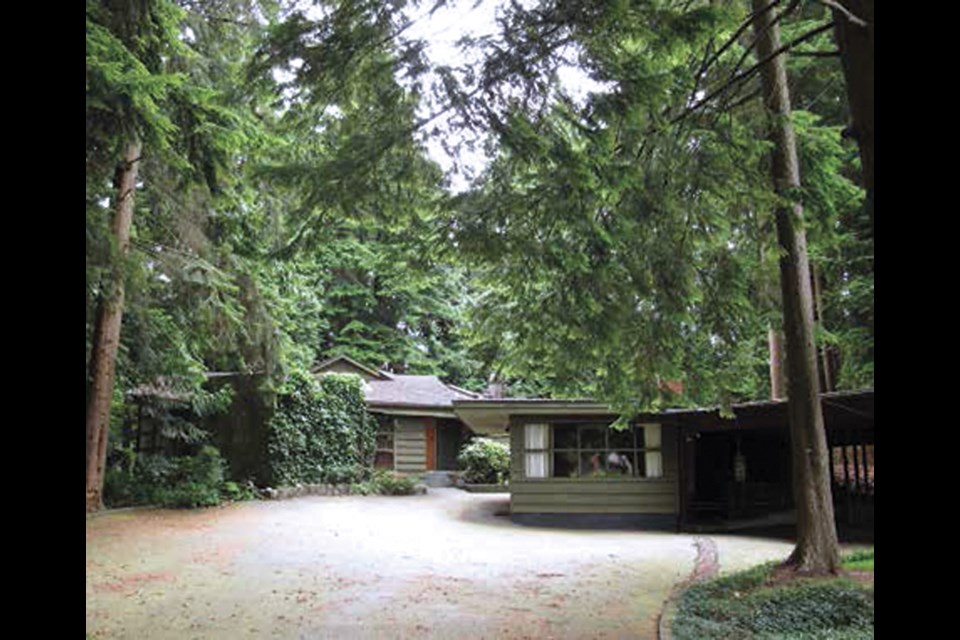A North Vancouver development company has been fined $200,000 by a judge for demolishing a heritage home by West Coast Modern architect Fred Hollingsworth, in contravention of a heritage revitalization agreement.
Developer 1160 Ridgewood Development Ltd. was handed the hefty fine by Judge Robert Hamilton in North Vancouver provincial court Monday (May 9) after pleading guilty to a charge under the Local Government Act. Vernacular Design Inc., an architectural company involved in representations about the property to the District of North Vancouver, was also fined $10,000 after pleading guilty to the same offence. Charges against the principal owners of those companies, Pouria Sadeghizadeh and Mehrdad Rahbar, were dropped.
The legal case revolved around the demolition of a designated heritage house on a forested lot in North Vancouver’s Edgemont neighbourhood.
Hollingsworth-designed home built in 1950
Known as the Forster Residence, the one-storey home and detached cabin on the property were designed by Hollingsworth and built in 1950.
The house exemplified many elements of West Coast Modern architecture developed after the Second World War, including integration of the building into its natural environment and use of natural light.
All that came crashing to the ground last summer, when developers “demolished the property when they didn’t have the permit to do so,” Crown counsel David McWhinnie told the judge. “There’s very little of it left at this point.”
Listed on the District of North Vancouver’s heritage building inventory, the Forster Residence was first subject to a heritage revitalization agreement between a former owner and the municipality in 2013, which provided for parts of the heritage house to be retained while also building an addition. But that plan stalled, and the house was left unattended for a lengthy period of time, said McWhinnie.
Property subject to heritage revitalization agreement
In 2020, the current developers bought the property and approached the municipality through Vernacular Design to re-establish the heritage revitalization agreement with slightly revised plans, based on a report by heritage consultant Donald Luxton.
A permit was granted (which included retaining 890 square feet of the original 2,150 square-foot house, plus a two-storey addition and coach house construction), with the understanding that “whatever was done to this property had to be consistent with the heritage alteration permit,” and if anything changed, the developer had to reapply, said McWhinnie.
When the developer started working on the property, however, the house was found to be in “substantially worse condition than was reflected in the report,” he said.
That’s where things went wrong, he said. “The next step should have been to go back to the district.” But that didn’t happen. “What happened instead was the substantial demolition of the property,” he said.
Much of the house was gone by July 2021
During the beginning of the trial in the case last month, heritage consultant Donald Luxton described showing up to the site in July 2021 for the first time in a year and finding much of the house gone. A portion of that was caused by natural deterioration, he said, noting water had seeped into the wooden structure that had then been allowed to sit unheated for a long period of time. No reinforcement had been used in building the concrete portions of the house, he added.
Other parts of the house – like the roof and interior walls – had been removed by the developer or his contractors, said Luxton, adding that this made it impossible to assess the extent of deterioration or if anything had been salvageable.
McWhinnie said while it’s a concern for the district that the municipality only found out about the demolition by chance, there’s no evidence to suggest intent to deceive.
The maximum fine in such cases against corporations is $1 million.
Deterrence important, says Crown
McWhinnie told the judge it’s important that the fine be substantial as a deterrent to others. “The district doesn’t want to create a situation where an opportunistic developer can get around the inconvenience of having to deal with a heritage property” by obtaining an HRA then taking down property and paying only “a nominal fine,” he said.
The development company always indicated an intention to plead guilty, he said, while an agreement on a joint submission with the architectural firm was reached after a trial started.
The district agreed to a lesser fine for the architect’s company, because he was acting in an advisory capacity and was not the owner of the property, said McWhinnie. He noted, however, that the architect had been on the property during the demolition and “should have picked up the phone and let the district know this [was] going on.”
Defence lawyer Nathan Lidder noted the principal of the development company, Sadeghizadeh, 30, is an accomplished developer and the top Realtor at his brokerage, who has agreed to personally guarantee the fine payments of more than $16,000 a month for the next year.
Destruction of heritage homes 'deeply upsetting': mayor
In a statement following the court decision, District of North Vancouver Mayor Mike Little said, “Heritage properties play an integral role in defining our community’s identity. The destruction of one of these properties is deeply upsetting to council and the community.”
Little said the municipality took the unusual step of going to court because “these properties are important and need to be protected.”
Little said the fine is the second largest of its kind imposed in Canada.
BC Assessment records indicate the property, bought for $1.2 million in January 2020, is now assessed at $2.1 million.
Under the district’s zoning bylaw, the owner can apply to build a single-family home of up to 3,500 square feet on the property.







